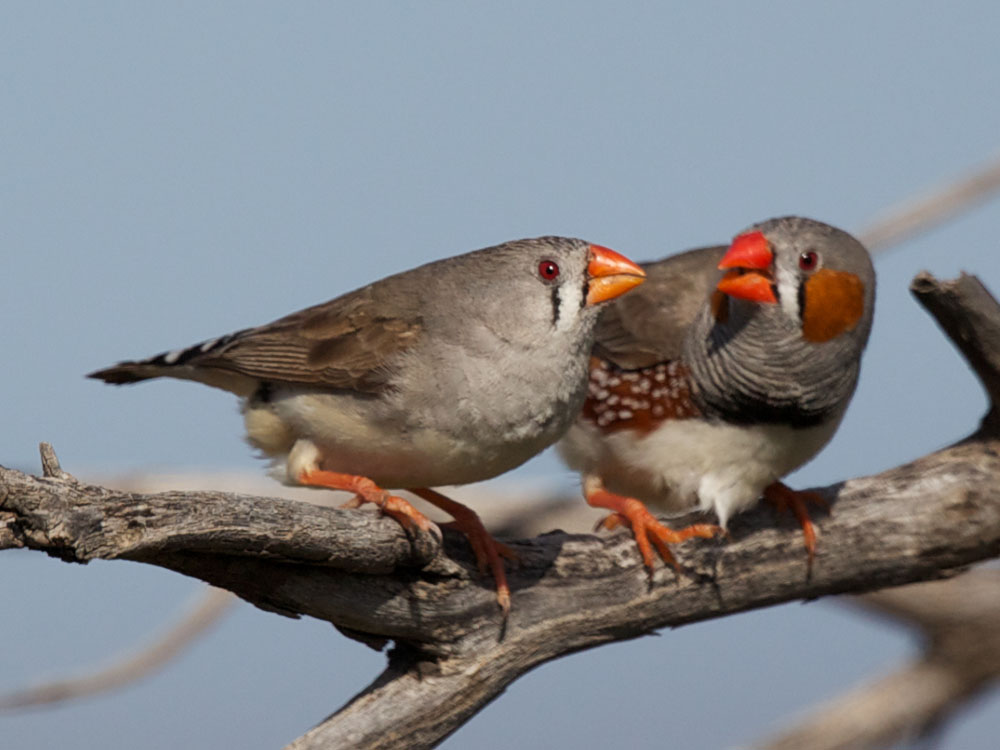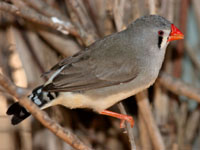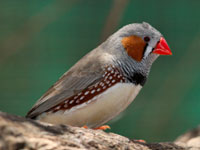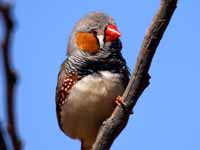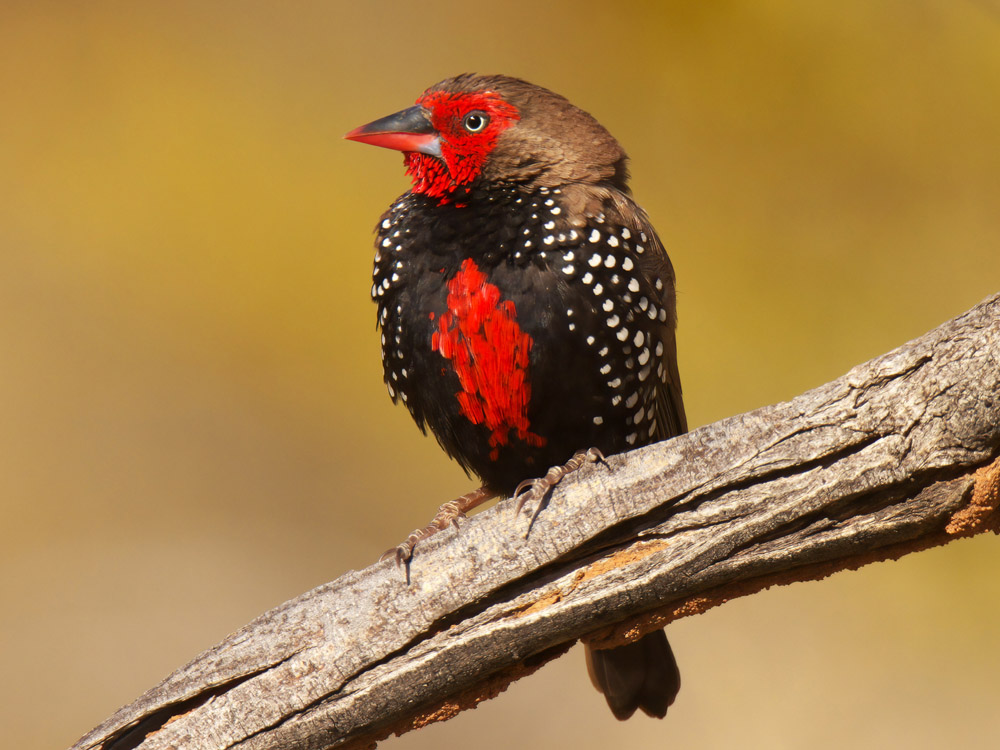The finches of family Estrildidae are small birds of the Old World tropics and Australasia. They are closely related to the true sparrows of family Passeridae. The estrilidid finches are gregarious and often seed-eaters with short, thick, but pointed bills. They vary from 8-17 cm. These finches are all similar in structure and habits, but vary widely in plumage colors and pattern. All the estrildids build large domed nests and lay 5–10 white eggs. Most are sensitive to cold and require a warm, usually tropical, habitat, although a few have adapted to the cooler climates of southern Australia. They are not closely related to the Fringillid Finches.
The 12 Erythrura species of parrotfinch are found in Southeast Asia, Australasia, and many Pacific islands. They are 9 to 15 cm long, are predominantly green and usually colorful with blue or red faces and red rumps. Most are seed eaters and will also eat some small insects. An exception is the red-headed parrotfinch which favors fruits such as figs. They are social, usually feeding in flocks. The parrotfinches of the Pacific islands such as the red-headed parrotfinch on Samoan islands, red-throated parrotfinch on New Caldonia, and the royal parrotfinch on Vanuatu are have small isolated populations which has evolved to have subtle differences. Since they are rarely photographed and poorly described, location is the best identifying feature.
The 27 mannikins and munias of genus Lonchura are found in Asia and Australasia. Some finches from Africa used to also be included in this genus, but they have been moved to Spermestes. They are small gregarious birds which feed mainly on seeds, usually in relatively open habitats, preferring to feed on the ground or on reeds of grasses. They have stubby bills, stocky bodies and long tails. Most are 10–12 cm in length. The plumage is usually a combination of browns, black and white. The are often in large flocks of 10 to 100 birds.
There are five firetail species, three of genus Stagonopleura, one in Oreostruthus, and one in Neochmia. They are noted for their bright red rumps, and they also have red bills. They are 11 to 13 cm long. Four of the firetails are found in Australia, the mountain firetail (Oreostruthus fuliginosus) is from New Guinea.
There are also 10 different species below that are called "finch" and they are spread over 8 different genera. They are a varied group, but like their other family members members they are social, specialize in eating seeds and thus have strong bills, and have covered nests with side entrances.
Genus Aidemosyne - 1 species
Finch,_Plum-headed Aidemosyne modesta
Description: The male plum-headed finch has olive-brown upperparts plus olive-brown wings with white spots, It has a deep purple forehead and chin, thus the "plum-headed" name. The deep purple usually looks black. It has white cheeks and black lores. The tail is black, the rump is white, and the underparts are white with brown bars at the edges. The female has a white chin. The plum-headed finch is about 11 cm long.
Range: Australia.
Habitat: Dry savanna and shrubland.
Diet: Grass seeds; also other seeds.
Conservation status: Least Concern.
Image by: 1, 4) David Cook 2) Tom Tarrant - Gatton, Queensland 3) First_KradRange: Australia.
Habitat: Dry savanna and shrubland.
Diet: Grass seeds; also other seeds.
Conservation status: Least Concern.
1, 2) Female 3, 4) Male
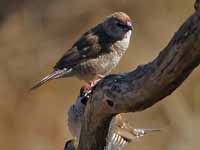
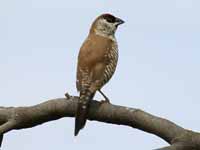

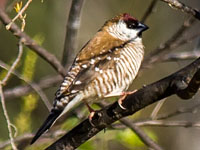
Genus Amandava
Avadavat,_Green also Green Munia Amandava formosa
Description: The green avadavat has green upperparts, and yellow underparts. It has black and white barred flanks and a red bill. The female is slightly paler than the male. It makes a ball shaped nest out of grass or sugar cane which has a side entrances. The green avadavat is about 10 cm long.
Range: Indian subcontinent.
Habitat: Dry scrub areas, agricultural land.
Diet: Grass seeds, small insects. It forages mainly on the ground.
Conservation status: It is listed as Vulnerable due to a declining population as a result of capture for pets.
Image by: 1, 2) Pkspks - India 3) The_PhotomationRange: Indian subcontinent.
Habitat: Dry scrub areas, agricultural land.
Diet: Grass seeds, small insects. It forages mainly on the ground.
Conservation status: It is listed as Vulnerable due to a declining population as a result of capture for pets.
1) Pair with female closest 2) Female 3) Male

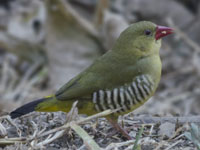
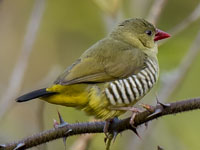
Avadavat,_Red also Red Munia Amandava amandava
Description: The breeding male red avadavat has red upperparts and breast. His lower-belly and wings have white spotting. There is some brown on his head and the belly is black. The nonbreeding male is duller but maintains a red rump. The female has greyish-brown upperparts, black lores,a red rump and under-tail coverts, and a few white spots on the wings. The nonbreeding male is similar to the female except for some white spots on the under-tail coverts. They have a red bill during breeding season and black otherwise. The red avadavat is about 10 cm long.
Range: South and southeast Asia.
Habitat: Flat plains, places near tall grass; often near water.
Diet: Grass seeds, small insects. Forages on the ground and also on grass stems.
Conservation status: Least Concern.
Image by:
1) Savisingh 2) Chinmay 3) Vijay Cavale 4) LonelyShrimp Range: South and southeast Asia.
Habitat: Flat plains, places near tall grass; often near water.
Diet: Grass seeds, small insects. Forages on the ground and also on grass stems.
Conservation status: Least Concern.
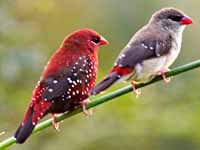
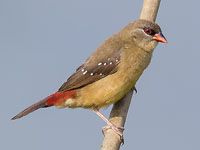
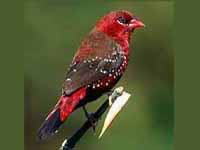
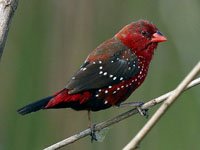
Waxbill, Orange-breasted Amandava subflava also Sporaeginthus subflavus
Description: The orange-breasted waxwing, also known as zebra waxbill, has dark olive-green upperparts, an orange breast, and a red bill. The "zebra" in its name refers to the white flanks which have dark bars. The male has a red supercilium. The female has duller plumage. The orange-breasted waxwing is small, about 9 cm long. The nest is ball shaped with a side entrance and a proch.
Range: Sub-Saharan Africa. Introduced in Kuwait and other countries.
Habitat: Grasslands and savannas.
Diet: Grass seeds, Insects. Forages on the ground or clinging to the grass.
Conservation status: Least Concern.
Image by :
Johan Spaedike 2) Alan Manson - South Africa 3, 4) Derek_Keats - South AfricaRange: Sub-Saharan Africa. Introduced in Kuwait and other countries.
Habitat: Grasslands and savannas.
Diet: Grass seeds, Insects. Forages on the ground or clinging to the grass.
Conservation status: Least Concern.
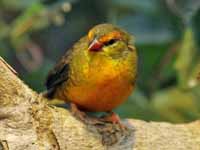
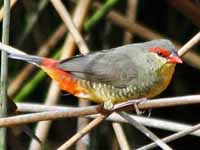
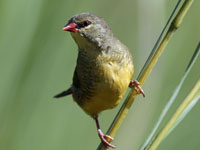
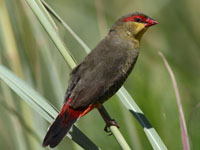
Genus Bathilda - 1 species
Finch,_Star Bathilda ruficauda
Description: The star finch has dark olive upperparts. The face and chin are red. There is a field of "star-bright" white spots on the olive throat, upper-breast, flanks, and tail. The lower-breast and belly are yellow-olive. The star finch is up to 12 cm long.
Range: Australia.
Habitat: Wet grasslands and swamps.
Diet: Grass seeds; also insects.
Conservation status: Least Concern.
Image by: 1) JJ Harrison 2) André Karwath 3, 4) Dick Daniels - Butterfly World Range: Australia.
Habitat: Wet grasslands and swamps.
Diet: Grass seeds; also insects.
Conservation status: Least Concern.
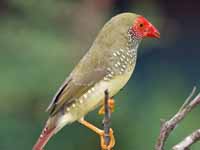
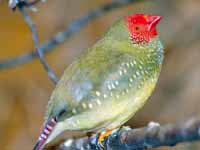
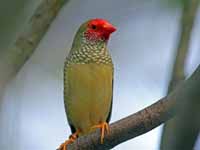
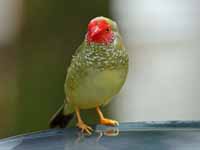
Genus Chloebia - 1 species
Finch,_Gouldian Chloebia gouldiae
Description: The Gouldian finch has a green back and a yellow belly. The male has a purple breast while the female is greyish purple. They have a blue rump and an ivory bill with a red tip. The chin is usually black with the rest of the head blue, red, or black, The Gouldian finch is about 15 cm long. The nest is constructed in a tree cavity or termite mound. There is widespread captive breeding, but it is now illegal to export them from Australia.The closest relatives are the finches of genus Erythrura.
Range: Australia.
Habitat: Grass areas, near woodlands.
Diet: Grass seeds. They are not known to eat insects.
Conservation status: It is listed as Near Threatened because of habitat destruction, especially by fires.
Image by: 1, 2)
Dick Daniels - Butterfly
World, Florida 3, 4) Dick - National Aviary Range: Australia.
Habitat: Grass areas, near woodlands.
Diet: Grass seeds. They are not known to eat insects.
Conservation status: It is listed as Near Threatened because of habitat destruction, especially by fires.
1) Female 2 - 4) Male
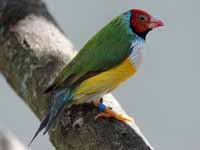
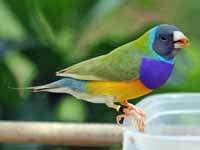
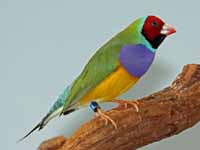
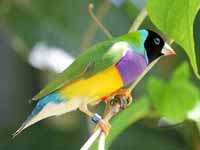
Genus Emblema - 1 species
Finch,_Painted also Painted Firetail Emblema pictum
Description: The painted finch, also known as the painted firetail, has brown upperparts including the crown. It has ared face, chin, mid-belly, and rump. Except for the red midsection, it has black underparts "painted" with white spots. The bill is bluish with a red tip. The female is slightly duller. The painted finch is about 11 cm long. The nest is ball shaped with a side entrance.
Range: Australia.
Habitat:. Arid areas with grasses and water available.
Diet: Grass seeds. Also fruit and blades of grass.
Conservation status: Least Concern.
Image by: 1, 2) Brian_McCauley 3) Jim Bendon 4) Jim_BendonRange: Australia.
Habitat:. Arid areas with grasses and water available.
Diet: Grass seeds. Also fruit and blades of grass.
Conservation status: Least Concern.
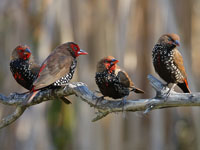

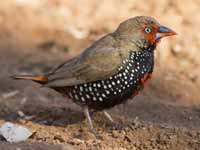
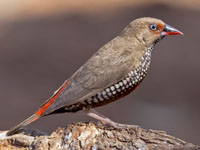
Genus Erythrura
The 12 species Erythrura parrotfinch are found in Southeast Asia, Australasia, and many Pacific islands. They are 9 to 15 cm long, are predominantly green and usually colorful with blue or red faces and red rumps. Most are seed eaters and will also eat some small insects, but the red-headed parrotfinch favors fruits such as figs. They are social, usually feeding in flocks. The parrotfinches of the Pacific islands such as the red-headed parrotfinch on Samoan islands, red-throated parrotfinch on New Caldonia, and the royal parrotfinch on Vanuatu are have small isolated populations which has evolved to have subtle differences. Since they are rarely photographed and poorly described, location is the best identifying feature.
Parrotfinch,_Blue-faced Erythrura trichroa
Description: The blue-faced parrotfinch has green upperparts and underparts. It has a blue face, fore-crown, and throat. The bill is black as are the lores. The blue-faced parrotfinch is 12 to 13 cm long.
Range: Mainly in New Guinea and surrounding islands. Also northern Australia.
Habitat: Rainforest edges, grasslands with woody plants.
Diet: Mainly grass seeds. Also other seeds, insects, berries.
Conservation status: Least Concern.
Image by: 1) Brian_McCauley - Australia 2) Dick Daniels - Bronx Zoo 3) Nrg800Range: Mainly in New Guinea and surrounding islands. Also northern Australia.
Habitat: Rainforest edges, grasslands with woody plants.
Diet: Mainly grass seeds. Also other seeds, insects, berries.
Conservation status: Least Concern.
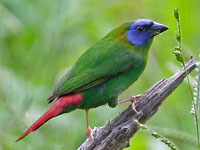
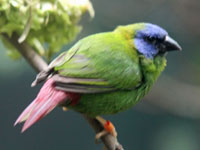

Parrotfinch,_Fiji Erythrura pealii
Description: The Fiji parrotfinch has mainly green plumage. It has a mostly red head and tail, black lores, black throat, and a stubby dark-grey bill. The upper-breast is blue. The female has less red on her head and also less blue on the breast. The Fiji parrotfinch is 10 cm long. It was formerly considered a subspecies of the red-headed parrotfinch.
Range: Fiji.
Habitat: Forests and also open grassy areas.
Diet: Seeds, especially grass. Also insects, nectar.
Conservation status: Least Concern.
Image by: 1, 2) Tom Tarrant 3) Arthur_ChapmanRange: Fiji.
Habitat: Forests and also open grassy areas.
Diet: Seeds, especially grass. Also insects, nectar.
Conservation status: Least Concern.
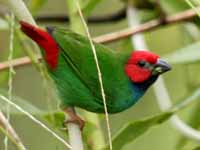
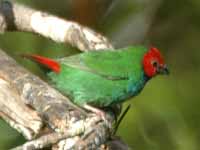

Parrotfinch,_Green-faced Erythrura viridifacies
Description: The green-faced parrotfinch has mainly green plumage. It has red upper-tail coverts, a long pointed tail, and a dark bill. The flight feathers have darker edges. The female is shorter and shows buff on her lower-belly, The green-faced parrotfinch is 12 to 13 cm long.
Range: Philippines.
Habitat: Forests, forest edges, savannah, bamboo groves.
Diet: Bamboo seeds, grass seeds, rice.
Conservation status: It is listed as Vulnerable as its population is small and decreasing.
Image by: 1) Chetatata 2) stamp_of_the_PhilippinesRange: Philippines.
Habitat: Forests, forest edges, savannah, bamboo groves.
Diet: Bamboo seeds, grass seeds, rice.
Conservation status: It is listed as Vulnerable as its population is small and decreasing.
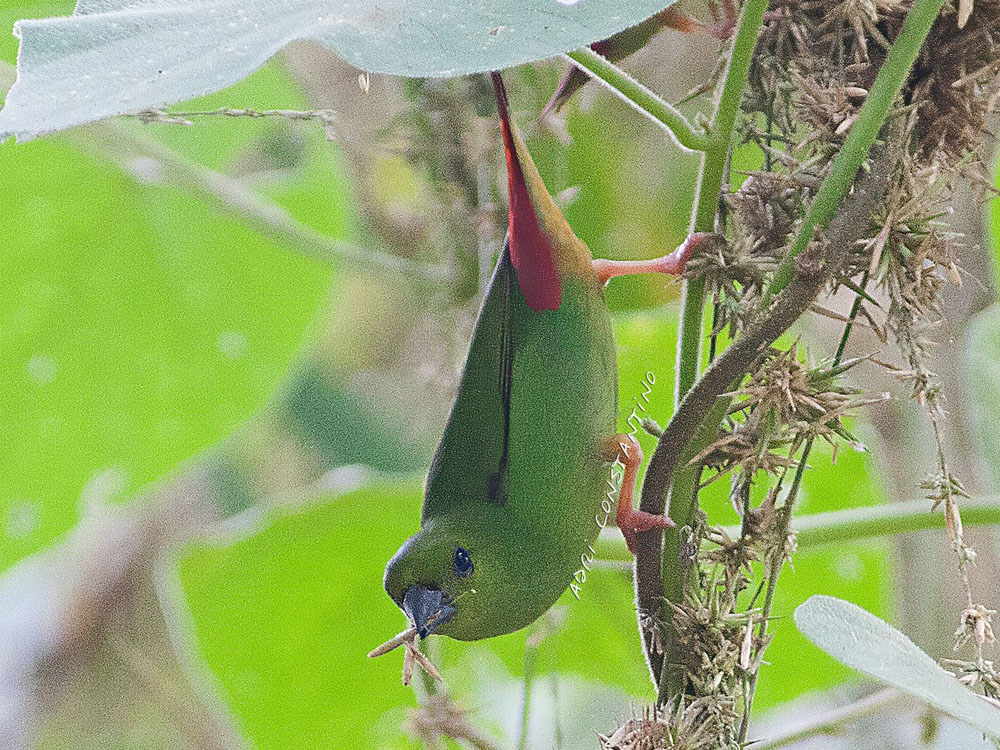

Parrotfinch,_Papuan Erythrura papuana
Description: The Papuan parrotfinch has green upperparts and a red tail. It has a mainly blue crown and blue face. The Papuan parrotfinch ia about 15 cm long. It is closely related to the blue-faced parrotfinch.
Range: New Guinea.
Habitat: Moist montane forests.
Diet: Grass seeds, fruits, insects.
Conservation status: Least Concern.
Image by: 1) Katerina_Tvardikova Range: New Guinea.
Habitat: Moist montane forests.
Diet: Grass seeds, fruits, insects.
Conservation status: Least Concern.
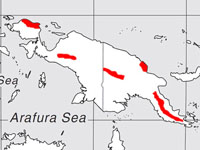
Parrotfinch,_Pink-billed Erythrura kleinschmidti
Description: The pink-billed parrotfinch has mainly green plumage. Its pink bill is much longer than the bills of other parrotfinches. The face is black and the crown plus nape are blue. The pink-billed parrotfinch is about 11 cm long.
Range: Fiji.
Habitat: Undisturbed mature forests.
Diet: Mainly insects. Also fruits, flower buds.
Conservation status: It is listed as Vulnerable due to deforestation.
Image by:
1) Joseph Smit 2) William_BeckonRange: Fiji.
Habitat: Undisturbed mature forests.
Diet: Mainly insects. Also fruits, flower buds.
Conservation status: It is listed as Vulnerable due to deforestation.


Parrotfinch,_Pin-tailed Erythrura prasina
Description: The pin-tailed parrotfinch has green upperparts including the wings, crown, and nape. It has a blue forehead, face, and throat. The underparts are light yellowish-brown. The long and pointed tail is red. Because the males tale is longer, his overall length is also longer. The pin-tailed parrotfinch is 12 to 15 cm long.
Range: Southeast Asia, Indonesia.
Habitat: Moist forests, bamboo groves, rice plantations.
Diet: Grass seeds, rice, and other seed. It is considered a pest by farmers because of its rice consumption.
Conservation status: Least Concern.
Image by:
1, 2) Jason Thompson 3) Chaval BR 4) NaturellyRange: Southeast Asia, Indonesia.
Habitat: Moist forests, bamboo groves, rice plantations.
Diet: Grass seeds, rice, and other seed. It is considered a pest by farmers because of its rice consumption.
Conservation status: Least Concern.
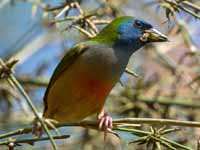

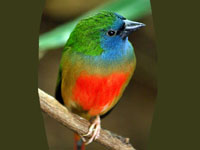
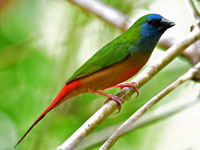
Parrotfinch,_Red-eared Erythrura coloria
Description: The red-eared parrotfinch has mainly green plumage. The forehead, fore-crown, and front of the face is blued. The rear of the face and the ear-coverts are red. It has a black bill.
Range: Mindanao (Philippines).
Habitat: Forest understory and edges, grassy areas.
Diet: Seeds, especially grass. Also insects.
Conservation status: Least Concern.
Range: Mindanao (Philippines).
Habitat: Forest understory and edges, grassy areas.
Diet: Seeds, especially grass. Also insects.
Conservation status: Least Concern.
Parrotfinch,_Red-headed Erythrura cyaneovirens
Description: The red-headed parrot-finch has a red head. There are conflicting reports that the upperparts are bluish-green or green.
Range: Samoan Islands.
Habitat: Forests with fruits available.
Diet: Mainly figs and other fruits. Also seeds and insects.
Conservation status: It is listed as Near Threatened because of losses due to storms and also bird capture for sale.
Range: Samoan Islands.
Habitat: Forests with fruits available.
Diet: Mainly figs and other fruits. Also seeds and insects.
Conservation status: It is listed as Near Threatened because of losses due to storms and also bird capture for sale.
Parrotfinch,_Red-throated Erythrura psittacea
Description: The red-throated parrotfinch has green plumage except for its red head, throat, breast, and rump. It is up to 14 cm long. The nest is spherical with a side entrance.
Range: New Caledonia (east of Australia).
Habitat: Moist lowland forests and shrublands.
Diet: Grass and other seeds, insects, fruiits.
Conservation status: Least Concern.
Image by:
1) LT Shears 2) Wiliam Kreijkes 3) David_RingerRange: New Caledonia (east of Australia).
Habitat: Moist lowland forests and shrublands.
Diet: Grass and other seeds, insects, fruiits.
Conservation status: Least Concern.
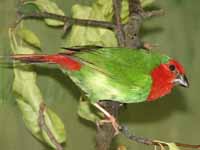
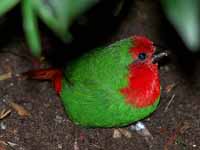

Parrotfinch,_Royal Erythrura regia
Description: The male royal parrotfinch has turquoise-green upperparts, red head, tail, and blue breast. Females are greener in color. It is about 11 cm long.
Range: Vauatu (south Pacific Ocean).
Diet: Fruits, seeds, insects.
Conservation status: It is listed as Vulnerable as logging is reducing its habitat.
Image by: 1) Joseph SmitRange: Vauatu (south Pacific Ocean).
Diet: Fruits, seeds, insects.
Conservation status: It is listed as Vulnerable as logging is reducing its habitat.
Two subspecies
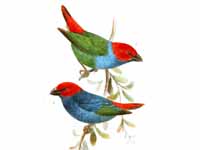
Parrotfinch,_Tawny-breasted Erythrura hyperythra
Description: The tawny-breasted parrotfinch has green upperparts including most of the crown. The forehead is black and bordered by a small amount of blue on the crown. The underparts, face, and throat are orange-brown (tawny). The bill is black. The awny-breasted parrotfinch is about 10 cm long.
Range: Indonesia, Malaysia, Philippines.
Habitat: Forest, forest edges, bamboo, scrub.
Diet: Grass and bamboo seeds, other seeds; also insects and fruits such as figs.
Conservation status: Least Concern.
Image by:
1) Shah Jahan - Java (Indonesia) Range: Indonesia, Malaysia, Philippines.
Habitat: Forest, forest edges, bamboo, scrub.
Diet: Grass and bamboo seeds, other seeds; also insects and fruits such as figs.
Conservation status: Least Concern.
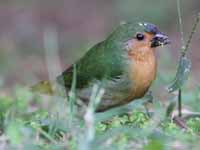
Parrotfinch,_Tricolored Erythrura tricolor
Description: The tricolored parrotfinch has a green back and wings, blue underparts and face, a red tail plus rump, and a black bill. The female has a paler blue than the male. It is about 10 cm long.
Range: Indonesia.
Habitat: Forest edges, thickets, bamboo.
Diet: Grass seeds, fruits. Forages mainly on the ground.
Conservation status: Least Concern.
Image by: 1) Sandy Cole - Butterfly World in
Florida 2, 3, 4, Dick Daniels - Butterfly World - Florida Range: Indonesia.
Habitat: Forest edges, thickets, bamboo.
Diet: Grass seeds, fruits. Forages mainly on the ground.
Conservation status: Least Concern.
1, 2) Female 3, 4) Male
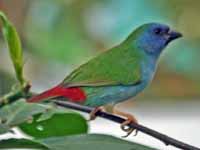
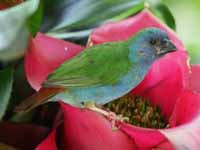
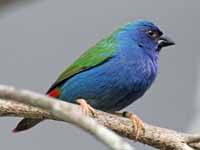
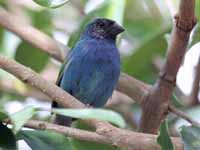
Genus Euodice
The African silverbill and Indian silverbill are closely related. Their eating habits are similar; they both are social species; and they build sphere shaped nests out of grass which a side entrance, and is placed in a bush. The grey-headed silverbill, which is found in Africa, is more distantly related.
Silverbill,_African Euodice cantans
Description: The African silverbill has light brown upperparts, and whitish underparts, It has a slivery blue bill. The wings, pointed tail, and rump are black. The African silverbill is about 10 cm long.
Range: Africa.
Habitat: Dry areas such as savanna, grasslands with acacias.
Diet: Mainly grass seeds.
Conservation status: Least Concern.
Image by: 1) Francesco_Veronesi - Kenya. 2) Edward Cwik 3) Frans_Vandewalle - Garbon 4) Nik_Borrow - EthiopiaRange: Africa.
Habitat: Dry areas such as savanna, grasslands with acacias.
Diet: Mainly grass seeds.
Conservation status: Least Concern.

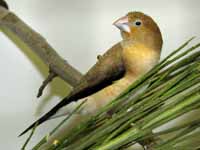

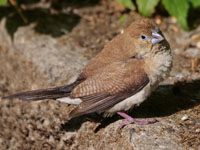
Silverbill, Indian Euodice malabarica
Description: The Indian silverbill, also known as the white-throated munia, has buff-brown upperparts, a silver-grey bill, white underparts, dark wings, and a black pointed tail.
Some individuals have a pronounced white rump while others have little or no white showing on the rump.
Range: Indian Subcontinent, Middle East. Introduced to Hawaii and other places.
Habitat: Dry scrubland.
Diet: Grass seeds and grain crops.
Conservation status: Least Concern.
Image by: 1) J. M. Garg - Haryana, India 2) DIck Daniels - Hawaii 3, 4) Dick- Butterfly World, Florida Range: Indian Subcontinent, Middle East. Introduced to Hawaii and other places.
Habitat: Dry scrubland.
Diet: Grass seeds and grain crops.
Conservation status: Least Concern.
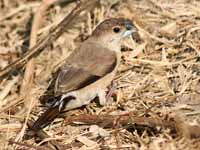
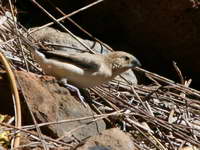

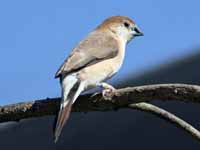
Genus Heteromunia - 1 species
Mannikin,_Pictorella Heteromunia pectoralis
Description: The pictorella mannikin, also known as the pictorella munia, has brownish-grey upperparts with the tail similar colored but darker. The wings have small white tips giving them a decorative appearance. It has a black face disk and white scaly upper-breast. The lower-breast and belly are pinkish buff. The pictorella mannikin is about 12 cm long.
Range: Northern Australia.
Habitat: Dry savanna and other grassy areas.
Diet: Grass and other seeds, including rice. Also insects and spiders. It forages mainly on the ground.
Conservation status: Least Concern.
Image by: 1, 2) Brian_McCauley 3) Jss367 - in captivityRange: Northern Australia.
Habitat: Dry savanna and other grassy areas.
Diet: Grass and other seeds, including rice. Also insects and spiders. It forages mainly on the ground.
Conservation status: Least Concern.
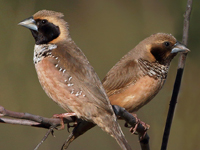
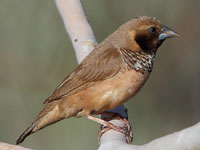

Genus Lonchura
The 27 mannikins and munias of genus Lonchura sare found in Asia and Australasia. Some finches from Africa used to also be included in this genus, but they have been moved to Spermestes. They are small gregarious birds which feed mainly on seeds, usually in relatively open habitats, preferring to feed on the ground or on reeds of grasses. They have stubby bills, stocky bodies and long tails. Most are 10–12 cm in length. The plumage is usually a combination of browns, black and white. The are often in large flocks of 10 to 100 birds.
A good number of the Lonchura species are found in New Guinea and nearby islands. They are present as a block to help with comparisons. Many of these species only have subtle differences.
Mannikin,_Black also Black Munia Lonchura stygia ,
Description: The black mannikin, also known as the black munia, has mainly black plumage. The bill is silvery and the rump yellow. The black mannikin is up to 11 cm long.
Range: New Guinea.
Habitat: Savannas, wetlands, rice fields.
Diet: Grass seeds and rice.
Conservation status: It is listed as Near Threatened due to reed-bed destruction by introduced deer. Livestock also competes for their habitat and black mannikins are capture for the bird trade.
Image by:
1) Katerina Tvardikova 2, 3) Aurelien LequoyRange: New Guinea.
Habitat: Savannas, wetlands, rice fields.
Diet: Grass seeds and rice.
Conservation status: It is listed as Near Threatened due to reed-bed destruction by introduced deer. Livestock also competes for their habitat and black mannikins are capture for the bird trade.
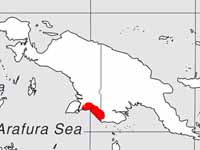


Mannikin,_Black-breasted Black-breasted Munia Lonchura teerinki
Description: The black-breasted mannikin, also known as the black-breasted munia, has brown to cinnamon-brown upperparts, The head is mainly black with the rear-crown brown. It has a black breast and white belly. The upper-tail is brown and yellow. It has a silver bill. The black-breasted mannikin is up to 11 cm long.
Range: New Guinea.
Habitat: Lowland shrubland and higher grasslands.
Diet: Grass and other seeds.
Conservation status: Least Concern.
Image by:
1, 2, 3) Aurelien LequoyRange: New Guinea.
Habitat: Lowland shrubland and higher grasslands.
Diet: Grass and other seeds.
Conservation status: Least Concern.

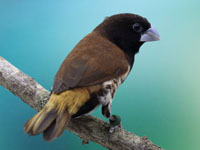
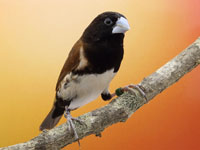
Mannikin,_Buff-bellied Lonchura melaena
Description: The buff-bellied mannikin, also known as the Bismarck munia, has a blackish brown mantle, brown lower back, rufous-buff rump and upper-tail. It has a black head, black and grey bill, and dark legs. The breast is black with white marks near the belly that is pinkish-buff. The buff-bellied mannikin is about 11 cm long.
Range: Papua New Guinea.
Habitat: Grasslands and other open areas.
Diet: Seeds.
Conservation status: Least Concern.
Image by: 1) Nik_Borrow Range: Papua New Guinea.
Habitat: Grasslands and other open areas.
Diet: Seeds.
Conservation status: Least Concern.
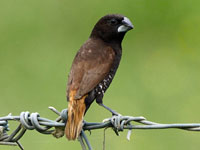
Mannikin,_Forbe's also New Ireland Munia Lonchura forbesi
Description: The Forbe's mannikin, also known as the New Ireland munia, has a rufous-brown back and wings. It has a black hood and a huge black bill. The underparts are buff and the rump is black. It has an orangish upper-tail. The Forbe's mannikin is up to 12 cm long.
Range: New Ireland of the Bismarck Archipelago.
Habitat: Dry grasslands.
Diet: Grass and other seeds.
Conservation status: Least Concern.
Image by:
1) Katerina_Tvardikova 2) Joseph_SmitRange: New Ireland of the Bismarck Archipelago.
Habitat: Dry grasslands.
Diet: Grass and other seeds.
Conservation status: Least Concern.
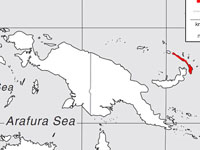
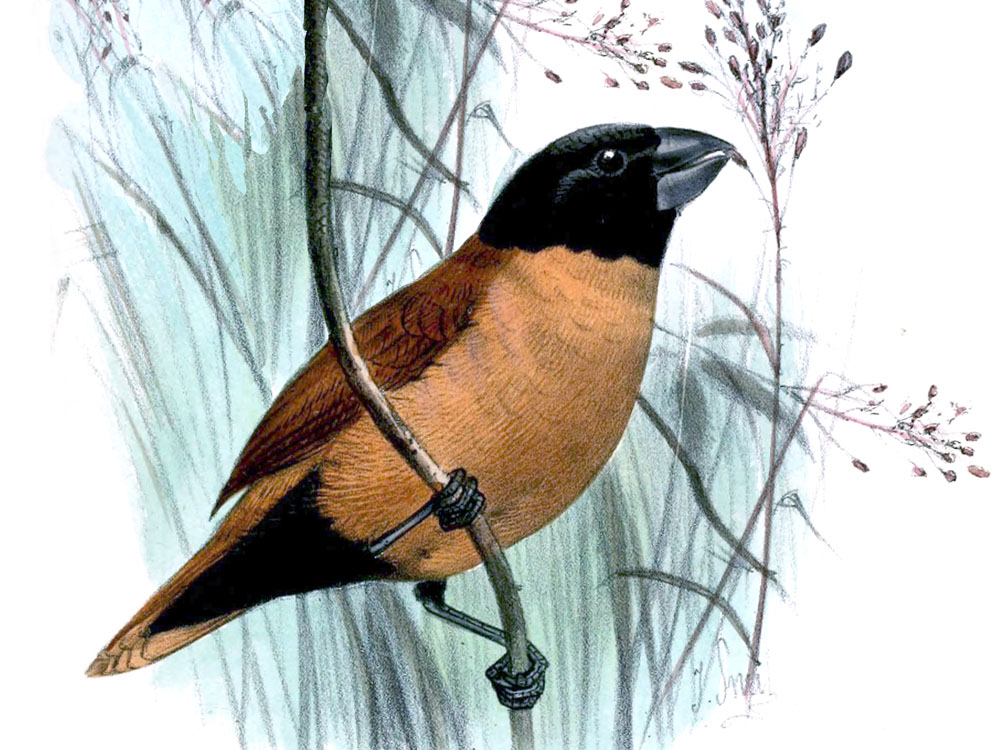
Mannikin,_Great-billed Lonchura grandis
Description: The great-billed mannikin, also known as the grand munia, has a black hood and orange rump. The rest of the upperparts are chestnut. The underparts are mainly black. It has a huge silvery bill. The great-billed mannikin is up to 12 cm long.
Range: Northern and eastern New Guinea.
Habitat: Wetlands.
Diet: Seeds; also insects.
Conservation status: Least Concern.
Image by:
1) Katerina_Tvardikova 2, 3, 4) Aurelien LequoyRange: Northern and eastern New Guinea.
Habitat: Wetlands.
Diet: Seeds; also insects.
Conservation status: Least Concern.

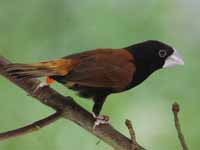

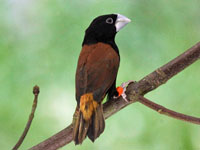
Mannikin,_Grey-banded Lonchura vana
Description: The grey-banded mannikin, also known as the grey-banded munia, has dark brown upperparts. It has a pale grey head with white forehead, a grey or brownish-grey breast-band, a paler and narrow lower band, and a rufous-brown belly. It has a large silvery bill.
Range: Northwest New Guinea.
Habitat: Grass lands, marsh lands.
Diet: Seeds. Information lacking about insect and other possilbe foods.
Conservation status: It is listed as Vulnerable because of a small range.
Range: Northwest New Guinea.
Habitat: Grass lands, marsh lands.
Diet: Seeds. Information lacking about insect and other possilbe foods.
Conservation status: It is listed as Vulnerable because of a small range.
Mannikin,_Grey-crowned also grey-crowned Munia Lonchura nevermanni Found: New Guinea
Description: The grey-crowned mannikin, also known as the grey-crowned munia, has brown upperparts. It has a grey fore-crown and face,. The massive bill is also grey. The rear-crown, nape, and throat are black. It has an orange rump. The underparts are brownish-orange. The grey-crowned mannikin is up to 12 cm long. The similar New Ireland munia has a black hood and bill - their ranges do not overlap.
Range: Southern New Guinea.
Habitat: Savanna, wetlands.
Diet: Grass seeds.
Conservation status: Least Concern.
Image by,
1) Katerina_Tvardikova Range: Southern New Guinea.
Habitat: Savanna, wetlands.
Diet: Grass seeds.
Conservation status: Least Concern.
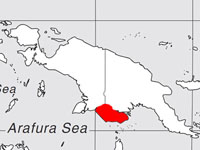
Mannikin,_Grey-headed Lonchura caniceps
Description: The grey-headed mannikin, also known as the grey-headed munia, has brown upperparts with an orange rump. It has a grey head, throat, and breast. The belly and under-tail coverts are black. The grey-headed mannikin is up to 11 cm long.
Range: Eastern New Guinea.
Habitat: Moist savanna, shrubland, wetlands.
Diet: Seeds, mainly grass.
Conservation status: Least Concern.
Image by: 1) Katerina_Tvardikova 2) Francesco_VeronesiRange: Eastern New Guinea.
Habitat: Moist savanna, shrubland, wetlands.
Diet: Seeds, mainly grass.
Conservation status: Least Concern.
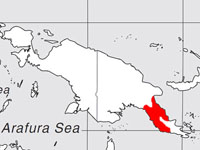
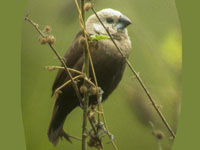
Mannikin,_Hooded Lonchura spectabilis
Description: The hooded mannikin, also known as the hooded munia, has brown upperparts and a golden rump. It has a black hood, large silver bill, and white underparts. The hooded mannikin is 10 cm long.
Range: Northern New Guinea, New Britain.
Habitat: Foothill grasslands.
Diet: Grass seeds.
Conservation status: Least Concern.
Image by:
1) Katerina Tvardikova 2) David Cook 3) Nik_BorrowRange: Northern New Guinea, New Britain.
Habitat: Foothill grasslands.
Diet: Grass seeds.
Conservation status: Least Concern.
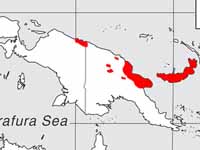
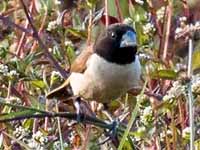
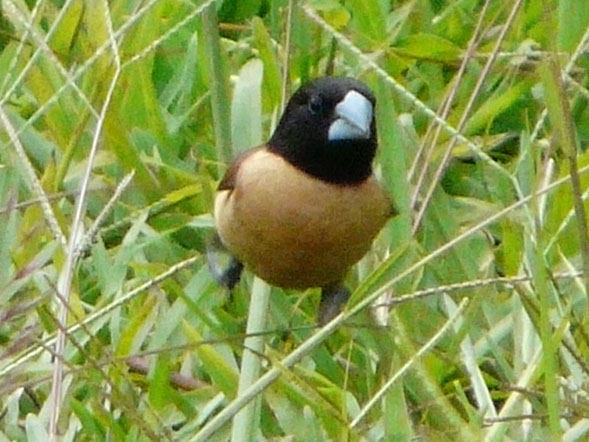
Mannikin,_Hunstein's also Mottled Munia Lonchura hunsteini
Description: The Hunstein's mannikin, also known as the mottled munia, has mainly black plumage. The head (except for the black throat), nape, and upper-mantle have a mottled grey appearance. The large bill is black. It has an orange rump and upper-tail coverts.
Range: New Hanover and New Ireland, both of the Bismarck Archipelago.
Habitat: Dry grasslands.
Diet: Grass and other seeds.
Conservation status: Least Concern.
Image by:
1) Katerina Tvardikova 2) John Gerrard Keulemans Range: New Hanover and New Ireland, both of the Bismarck Archipelago.
Habitat: Dry grasslands.
Diet: Grass and other seeds.
Conservation status: Least Concern.

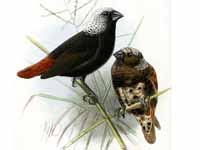
Mannikin,_New Hanover also New Hanover Munia Lonchura nigerrima Found: Papua New Guinea
Description: The New Hanover mannikin, also known as the New Hanover munia, is also considered a subspecies of the Hunstein's mannikin. The New Hanover mannikin can be differentiated from the Hunstein's by its all black head.
Range: New Hanover of the Bismarck Archipelago.
Habitat: Dry grasslands.
Diet: Grass and other seeds.
Conservation status: Least Concern.
Range: New Hanover of the Bismarck Archipelago.
Habitat: Dry grasslands.
Diet: Grass and other seeds.
Conservation status: Least Concern.
Mannikin,_Western Alpine Lonchura montana
Description: The western alpine mannikin, also known as the snow mountain munia, has dark brown upperparts, a black face, buff breast, and whitish belly with faint black bars. The western alpine mannikin is up to 12 cm long.
Range: Wetern New Guinea.
Habitat: Alpine grasslands.
Diet: Grass and other seeds.
Conservation status: Least Concern.
Image by: 1) Aurelien LequoyRange: Wetern New Guinea.
Habitat: Alpine grasslands.
Diet: Grass and other seeds.
Conservation status: Least Concern.

End of the New Guinea species
Mannikin,_Chestnut Lonchura atricapilla
Description: The chestnut mannikin, also known as the chestnut munia, also known as the black-headed munia, has mainly chestnut brown plumage including the, wings and tail. It has a black head, black throat and upper-breast. The bill is grey.
Range: Asia, Philippines. Introduced Hawaii.
Habitat: Grasslands, rice paddies, and other open area.
Diet: Seeds, rice.
Conservation status: Least Concern.
Image by: 1) DIck Daniels - Kauai, Hawaii 2) Neko Katya 3) Johnny_Wee 4) Aurelien_LequoyRange: Asia, Philippines. Introduced Hawaii.
Habitat: Grasslands, rice paddies, and other open area.
Diet: Seeds, rice.
Conservation status: Least Concern.

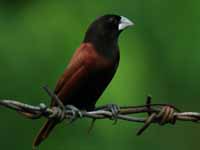
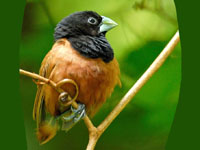
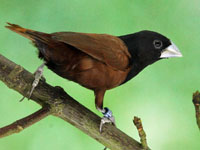
Mannikin,_Chestnut-breasted Lonchura castaneothorax
Description: The chestnut-breasted mannikin, also known as the chestnut-breasted munia, has a brown back, black face, grey crown, and grey nape. It has a chestnut breast with a black border above its white belly. It has black and white streaked flanks.
Range: Australasia.
Habitat: Savanna and other grassy areas. Croplands.
Diet: Barley seeds, grass seeds, and other seeds.
Conservation status: Least Concern.
Image by: 1) Aviceda 2) fir0002 - Victoria, AU 3) Ian_Sutton 4) Brian_McCauleyRange: Australasia.
Habitat: Savanna and other grassy areas. Croplands.
Diet: Barley seeds, grass seeds, and other seeds.
Conservation status: Least Concern.

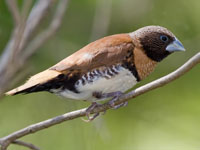

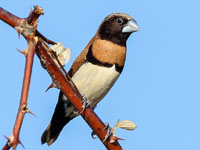
Mannikin,_Nutmeg Lonchura punctulata
Description: The nutmeg nannikan, also known as the scaly-breasted munia, also known as the spice finch, has brown upperparts, scale-like markings on the underparts, and a large dark bill.
Range: Asia. Introduced: Australia, Hawaii.
Habitat: Tropical plains and grasslands.
Diet: Grass seeds. Also small insects and berries.
Conservation status: Least Concern.
Image by: 1, 2) Dick Daniels - Kauai, Hawaii 3) Shrikant_Rao - India 4) Antony Gros - IndiaRange: Asia. Introduced: Australia, Hawaii.
Habitat: Tropical plains and grasslands.
Diet: Grass seeds. Also small insects and berries.
Conservation status: Least Concern.
1) Juvenile
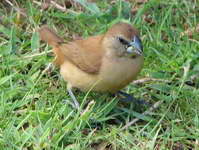
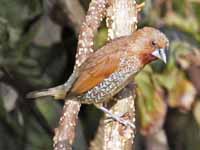
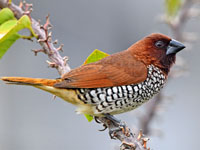
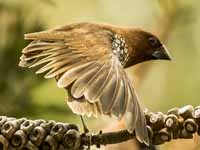
Mannikin,_White-rumped Lonchura striata
Description: The white-rumped mannikin, also known as the white-rumped munia, has brown upperparts, head, and upper breast. It has a whitish lower-breast, belly, and a white rump. The white-rumped mannikin is up to 11 cm long.
Range: Southern Asia, Indonesia, Malaysia.
Habitat: Grasslands, scrublands, and open woodlands.
Diet: Seeds; also algae.
Conservation status: Least Concern.
Image by:
1) Vengolis 2) JM Garg - India 3) Charles Lam 4) Thomas_BrownRange: Southern Asia, Indonesia, Malaysia.
Habitat: Grasslands, scrublands, and open woodlands.
Diet: Seeds; also algae.
Conservation status: Least Concern.
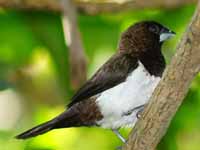

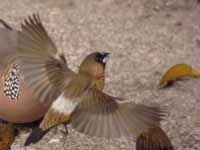
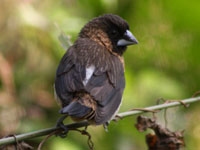
Mannikin,_Yellow-rumped Lonchura flaviprymna
Description: The yellow-rumped mannikin, also known as the yellow-rumped munia, has ra ufous-brown back and wings. The head and underparts are off-white, sometimes with a yellow tinge to the underparts. The bill is ivory-colored; it has a yellow-rump. The yellow-rumped mannikin is about 12 cm long.
Range: The Northwest Territory of Australia.
Habitat: Moist savanna, wetlands, mangroves.
Diet: Grass seeds.
Conservation status: Least Concern.
Image by:
1) Henrik Gronvold 2) Katie and Tommy Range: The Northwest Territory of Australia.
Habitat: Moist savanna, wetlands, mangroves.
Diet: Grass seeds.
Conservation status: Least Concern.
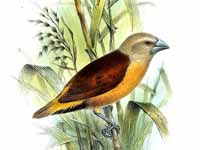

Munia,_Black-faced Lonchura molucca
Description: The black-faced munia has rufous brown upperparts, a black head, and black throat. It has a bluish-grey bill with the upper part darker. The underparts are pale with fine black speckling and barring.
Range: Indonesia.
Habitat: Savanna, grasslands, parks, gardens.
Diet: Mainly seeds.
Conservation status: Least Concern.
Image by:
1) Gollo71 2) John_TasirinRange: Indonesia.
Habitat: Savanna, grasslands, parks, gardens.
Diet: Mainly seeds.
Conservation status: Least Concern.
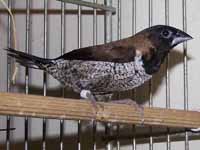

Munia,_Black-throated Lonchura kelaarti
Description: The black-throated munia dark has brown upperparts. It has a blackish head, breast, and wings. The bill is grey. The Kelaarti subspecies has whitish underparts with scaly patterning. The Jerdoni subspecies has pinkish brown underparts with scaly marking towards the vent. The black-throated munia is 12 cm long.
Range: India, Sri Lanka.
Habitat: Grassy areas, scrubland, gardens.
Diet: Grass and other seeds, Maybe some insects.
Conservation status: Least Concern.
Image by: 1) John Gerrard Keulemans 2) L_Shyamal 3) Raveen and VaruniRange: India, Sri Lanka.
Habitat: Grassy areas, scrubland, gardens.
Diet: Grass and other seeds, Maybe some insects.
Conservation status: Least Concern.
1) L. k. kelaarti 2, 3) L. k. jerdoni
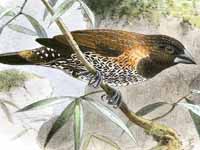
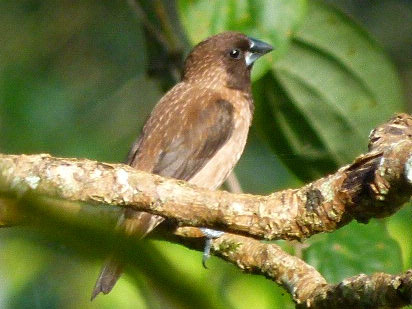

Munia,_Dusky Lonchura fuscans
Description: The dusky munia has mainly dusky brown plumage which is sometimes mottled. The upper-bill is mostly black and the lower bill is grey. The dusky munia is about 11 cm long.
Range: Borneo.
Habitat: Shrubland, forest edges, grassland.
Diet: Grass and other seeds including rice. Also insects.
Conservation status: Least Concern.
Image by:
1, 2) Wibowo Djatmiko 3) LonelyShrimpRange: Borneo.
Habitat: Shrubland, forest edges, grassland.
Diet: Grass and other seeds including rice. Also insects.
Conservation status: Least Concern.

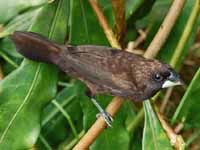
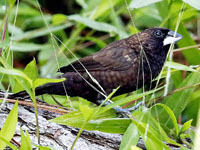
Munia,_Five-colored Lonchura quinticolor
Description: The five-colored munia has chestnut upperparts including the rump. The head is darker and it hasa silver bill. It has white underparts. The five-colored munia is up to 12 cm long.
Range: Lesser Sunda Islands of Indonesia.
Habitat: Grasslands, rice fields.
Diet: Grass seeds, rice.
Conservation status: Least Concern.
Image by:
1) Ron Knight Range: Lesser Sunda Islands of Indonesia.
Habitat: Grasslands, rice fields.
Diet: Grass seeds, rice.
Conservation status: Least Concern.
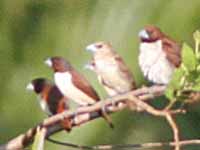
Munia,_Javan Lonchura leucogastroides
Description: The Javan munia has dark brown upperparts including the rear-crown and nape. The fore-crown, face, throat, u[[er-breast, wings, tail, and rump are black. The lower-breast and belly are white.
Range: Indonesia.
Habitat: Grasslands and shrublands.
Diet: Grass, rice, and other seeds.
Conservation status: Least Concern.
Image by:
1) Lip Kee 2) Melvin Yap 3) Lip KeeRange: Indonesia.
Habitat: Grasslands and shrublands.
Diet: Grass, rice, and other seeds.
Conservation status: Least Concern.
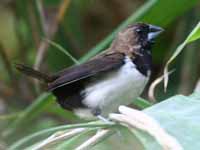
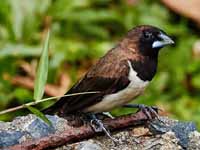
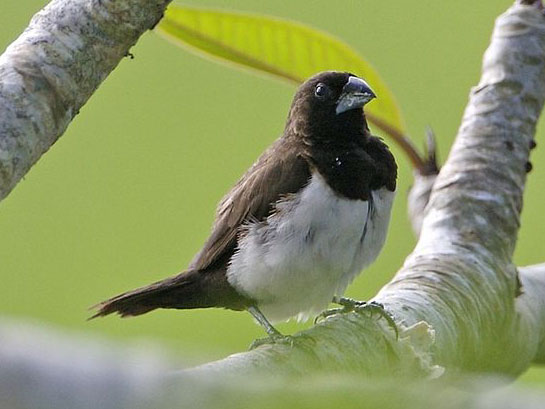
Munia,_Pale-headed Lonchura pallida
Description: The pale-headed munia has brown upperparts with a dark brown tail. It has a white head and throat. The upper-breast is white becoming greyer on the lower-breast. The belly is reddish-orange. The pale-headed munia is up to 11 cm long.
Range: Indonesia.
Habitat: Dry grasslands and shrublands.
Diet: Seeds and rice.
Conservation status: Least Concern.
Image by:
1, 2) Aurelin Lequoy 3) Francesco_Veronesi - SulawesiRange: Indonesia.
Habitat: Dry grasslands and shrublands.
Diet: Seeds and rice.
Conservation status: Least Concern.
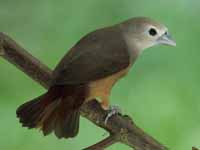

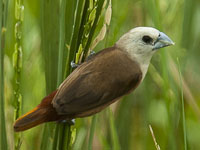
Munia,_Tricolored Lonchura malacca
Description: The tricolored munia is a mix of black, chestnut, and white plumage. It has a chestnut back; black head, neck, and belly; plus it has a white breast and flanks. The juvenile nutmeg mannikan and juvenile tricolored munia are similar. One way to tell them apart is to look for some adults in the vicinity.
Range: Asia. Introduced: South America.
Habitat: Wet grasslands and most forest areas.
Diet: Grass seeds.
Conservation status: Least Concern.
Image by: 1) Krayker - India 2) Davidvraju 3) Imran_Shah - Pakistan 4) Savithri_SinghRange: Asia. Introduced: South America.
Habitat: Wet grasslands and most forest areas.
Diet: Grass seeds.
Conservation status: Least Concern.
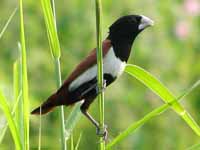
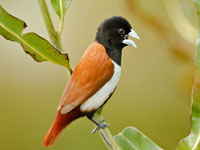
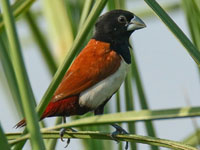
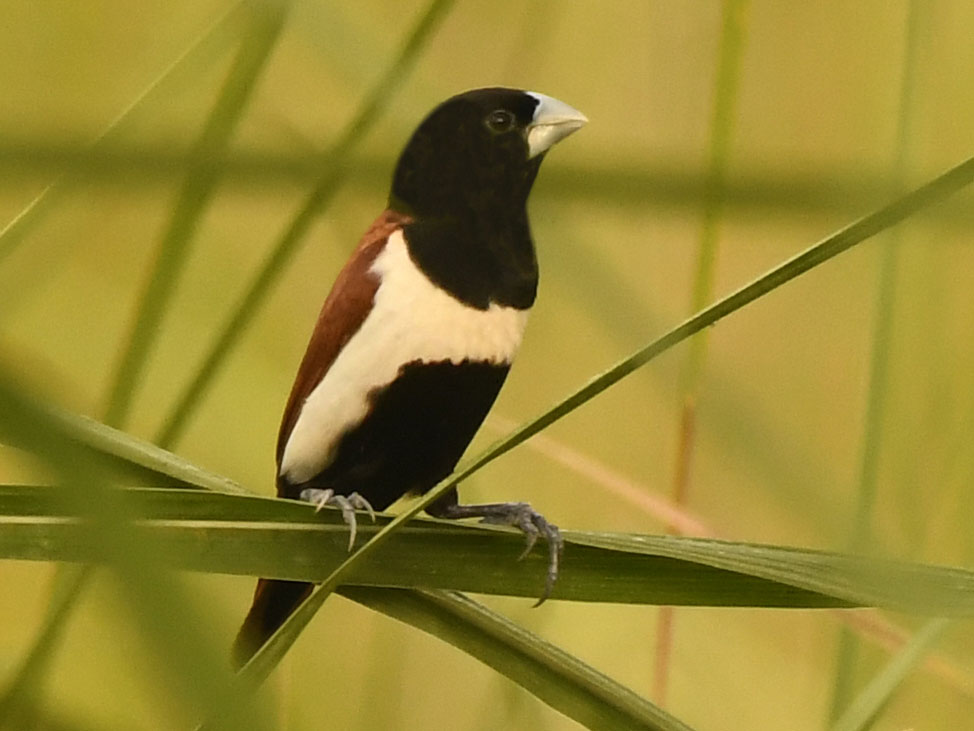
Munia,_White-bellied Lonchura leucogastra
Description: The white-bellied munia has dark brown upperparts with thin white lines. It has a dark brown breast and white belly. It has a grey bill. The white-bellied munia is about 11 cm long.
Range: Southeast Asia, Indonesia, Malaysia, Philippines.
Habitat: Wet grasslands, rice fields, moist forests.
Diet: Grass seeds, rice, and other seeds.
Conservation status: Least Concern.
Image by:
1) Grandpa_at_50 2) Aaron_MaizlishRange: Southeast Asia, Indonesia, Malaysia, Philippines.
Habitat: Wet grasslands, rice fields, moist forests.
Diet: Grass seeds, rice, and other seeds.
Conservation status: Least Concern.
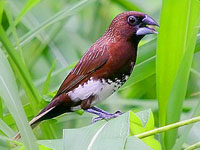
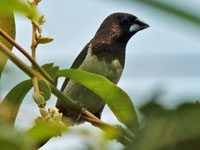
Munia,_White-capped Lonchura ferruginosa
Description: The white-capped munia has chestnut upperparts including the tail. It has a whitish head, black throat and upper-breast, rufous lower-breast and flanks, and a black belly. The bill is silver. The white-capped munia is up to 12 cm long.
Range: Java and Bali of Indonesia.
Habitat: Grass lands, marshes.
Diet: Grass seeds, and rice.
Conservation status: Least Concern.
Image by:
1) Jean_Pretre 2) Aurelien LequoyRange: Java and Bali of Indonesia.
Habitat: Grass lands, marshes.
Diet: Grass seeds, and rice.
Conservation status: Least Concern.
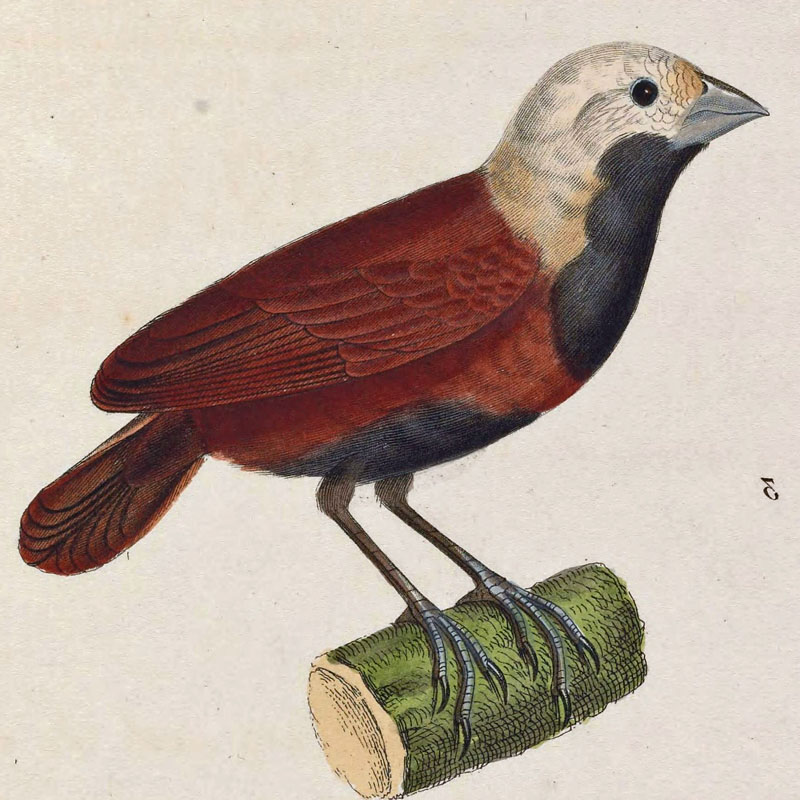

Munia,_White-headed Lonchura maja
Description: The white-headed munia has mainly brown plumage,. It also has a white head, white throat, and and a whitish-brown upper-breast. The white-headed munia is about 11 cm long.
Range: Indonesia, Malaysia, Singapore, Thailand, Vietnam, Portugal (introduced).
Habitat: Grasslands, marshes, rice fields.
Diet: Grass, rice, and other seeds.
Conservation status: Least Concern.
Image by: 1) LonelyShrimp - Malaysia 2) Bob_PS - Malaysia 3) Aurelien_Lequoy 4) Melindra12Range: Indonesia, Malaysia, Singapore, Thailand, Vietnam, Portugal (introduced).
Habitat: Grasslands, marshes, rice fields.
Diet: Grass, rice, and other seeds.
Conservation status: Least Concern.


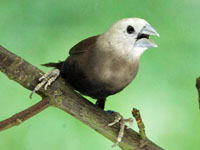

Genus Mayrimunia - 1 species
Mannikin,_Streak-headed Mayrimunia tristissima
Description: The streak-headed mannikin, also known as the streak-headed munia, has brown upperparts with light streaking on head. It has yellowish-rump and black tail. The breast is brown and the belly is blackish. The streak-headed mannikin is about 11 cm long. The white-spotted mannikin (M. t. leucosticta) is sometimes considered to be a separated species.
Range: New Guinea.
Habitat: Grassy edges of streams, forest clearings, abandoned gardens.
Diet: Mainly seeds. Also berries, insects.
Conservation status: Least Concern.
Image by: 1, 2) Katerina_TvardikovaRange: New Guinea.
Habitat: Grassy edges of streams, forest clearings, abandoned gardens.
Diet: Mainly seeds. Also berries, insects.
Conservation status: Least Concern.
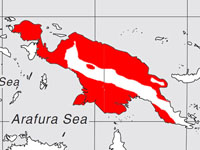
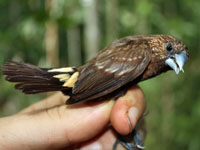
Genus Neochmia
Finch,_Crimson Neochmia phaeton
Description: The crimson finch has a white bellied race and a black bellied race. Both have mainly crimson plumage. It has a black mid-crown and a few white specks along the sides. The crimson finch is about 13 cm long. Their nest is usually created in a hollow tree limb.
Range: Australia, New Guinea.
Habitat: Tall grasses near water.
Diet: Grass seeds, rice; also insects.
Conservation status: Least Concern.
Image by: 1) Katerina_Tvardikova 2, 3) Geoff Whalen 4) SummerdroughtRange: Australia, New Guinea.
Habitat: Tall grasses near water.
Diet: Grass seeds, rice; also insects.
Conservation status: Least Concern.
2, 3) Female 4) Male
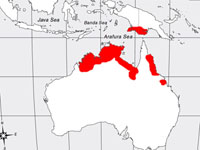
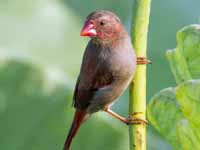
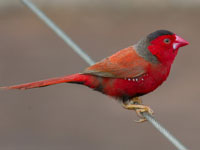

Firetail,_Red-browed Neochmia temporalis
Description: The red-browed firetail, also known as the red-browed finch, has olive-green upperparts. There is a yellowish-green partial collar. It has a bright red stripe above each eye. The rump and under-tail coverts are also red as is the bill. The underparts are grey as is the head, except for the red stripes. The red-browed firetail is up to 12 cm long.
Range: Eastern Australia.
Habitat: Open woodlands, forest edges,
Diet: Seeds.
Conservation status: Least Concern.
Image by: 1) JJ_Harrison - New South Wales 2) James_Niland - Queensland 3) Tatters:) - Queensland 4) KazredracerRange: Eastern Australia.
Habitat: Open woodlands, forest edges,
Diet: Seeds.
Conservation status: Least Concern.
1) Juvenile
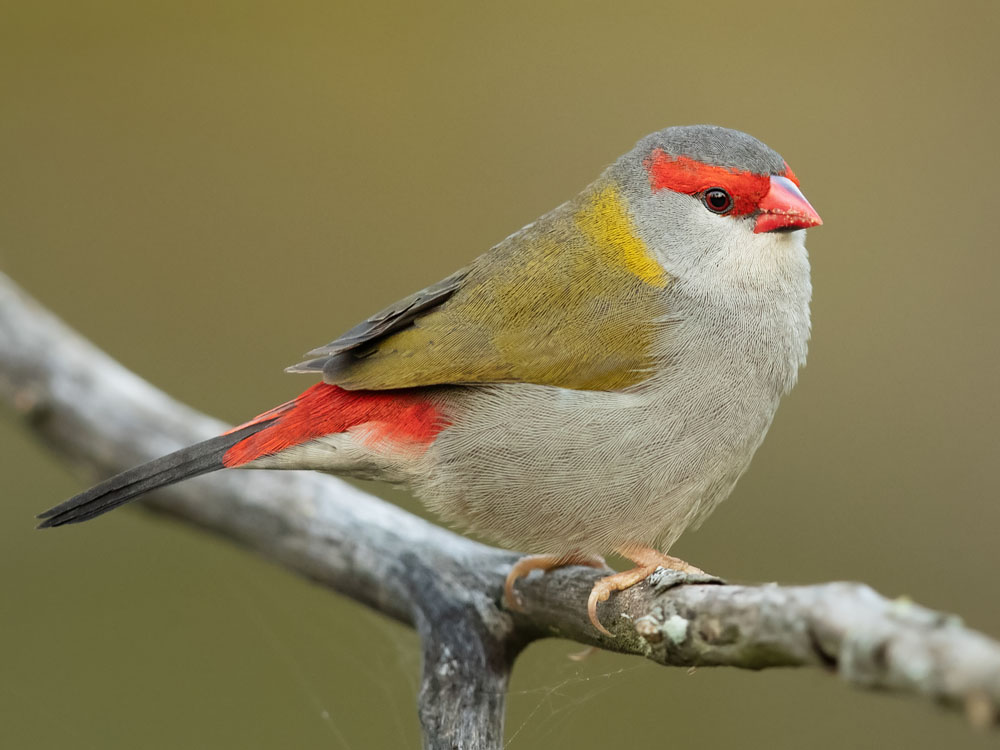
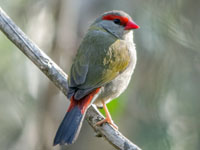
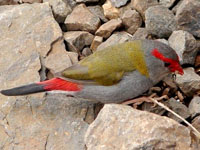
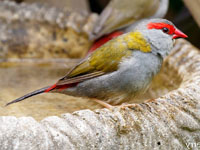
Genus Oreostruthus - 1 Genus
Firetail,_Mountain Oreostruthus fuliginosus
Description: The mountain firetail has olive-brown upperparts and a greyish crown. It has a red rump and upper-tail coverts. The male has an entirely red bill; the female has a black upper-bill and red lower-bill. The underparts are red with variable amounts of brown showing. The mountain firetail is about 13 cm long.
Range: New Guinea.
Habitat: Alpine grasslands and forest edges. Usually above 2000 m.
Diet: Grass seeds. Also insects.
Conservation status: Least Concern.
Image by: 1, 2) Nik_BorrowRange: New Guinea.
Habitat: Alpine grasslands and forest edges. Usually above 2000 m.
Diet: Grass seeds. Also insects.
Conservation status: Least Concern.
1) Female 2) Male
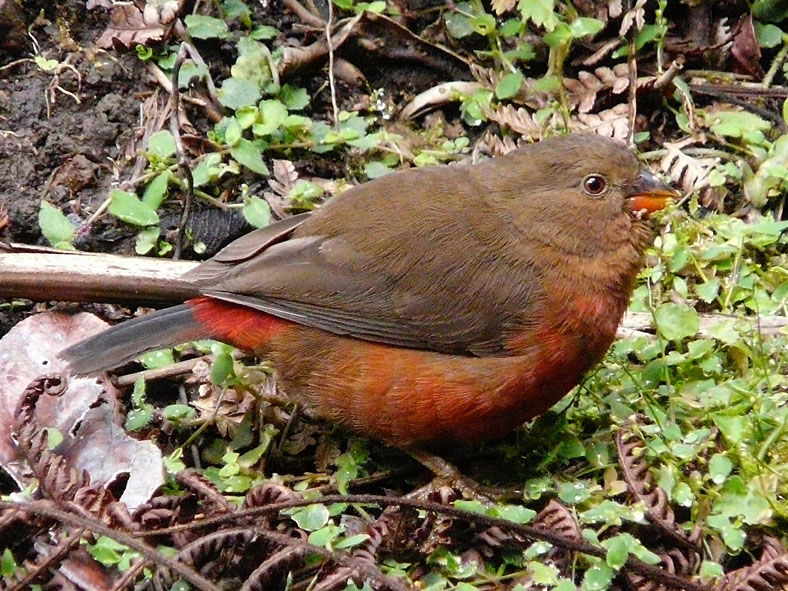
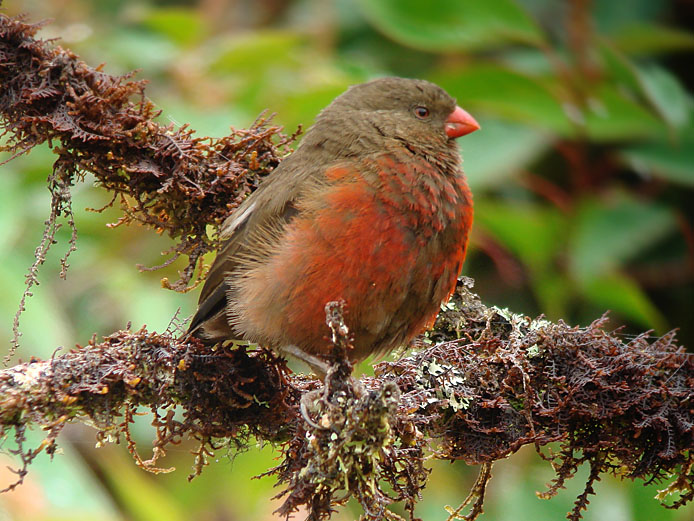
Genus Padda
Both species have white-cheeked black heads and thick bills. Finch,_Java also Java Sparrow Padda oryzivora
Description: The Java finch, also known as the Java sparrow, has grey upperparts and breast.It has a pink belly, white-cheeked black head, red eye-ring, thick red bill, and pink feet. The Java finch is 15 to 17 cm long and about 25 gram. The similar Timor sparow has brown upperparts.
Range: Indonesia, especially on Java. Introduced: Hawaii, Puerto Rico, , Australia .
Habitat: Grasslands, and crop lands.
Diet: Grain and other seeds.
Conservation status: It is listed as Critically endangered because it is uncommon in its native habitat. That said, because it has been widely introduced elsewhere, it is not in danger of extinction.
Image by: 1, 2, 3, 4) DIck Daniels - Hawaii Range: Indonesia, especially on Java. Introduced: Hawaii, Puerto Rico, , Australia .
Habitat: Grasslands, and crop lands.
Diet: Grain and other seeds.
Conservation status: It is listed as Critically endangered because it is uncommon in its native habitat. That said, because it has been widely introduced elsewhere, it is not in danger of extinction.
1) Juvenile
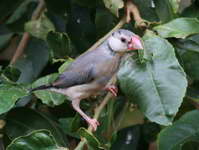
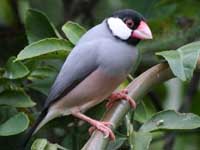
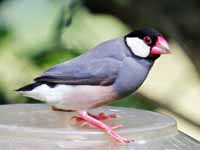
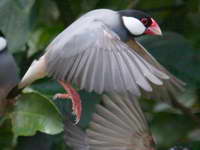
Sparrow, Timor Padda fuscata
Description: The Timor sparrow has brown upperparts and breast. The bill is silvery blue and the cheeks white. It has a black crown and throat. The belly is creamy-white. The Timor sparrow is about 14 cm long. The similar Java sparow has grey upperparts while Timor sparrow has brown upperparts and breast.
Range: Lesser Sundas (Timor, Rote, and Semau).
Habitat: Grasslands and low lands.
Diet: Rice and other seeds.
Conservation status: It is listed as Near Threatened because of habitat loss.
Range: Lesser Sundas (Timor, Rote, and Semau).
Habitat: Grasslands and low lands.
Diet: Rice and other seeds.
Conservation status: It is listed as Near Threatened because of habitat loss.
Genus Poephila
These species prefer dry grassland. They have buff or brown upperparts, pinkish upperparts, black tail.
Finch,_Black-throated Poephila cincta
Description: The black-throated finch has light brown upperparts. The head is pale grey with black lores and a white face. It has a black throat. The black bill is small for an Estrildid finch. The black-throated finch is about 11 cm long.
Range Northeast Australia.
Habitat: Grassy woodlands.
Diet: Grass seeds; also insects during the breeding season. Forages mainly on the ground.
Conservation status: It is listed as Endangered because some subspecies have declined from loss of seed producing plants.
Image by: 1) Nrg800 2, 3) Brian_McCauley 4) Dominic Sherony Range Northeast Australia.
Habitat: Grassy woodlands.
Diet: Grass seeds; also insects during the breeding season. Forages mainly on the ground.
Conservation status: It is listed as Endangered because some subspecies have declined from loss of seed producing plants.
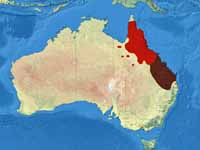


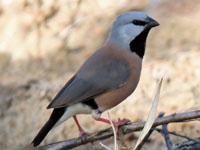
Finch,_Long-tailed Poephila acuticauda
Description: The long-tailed finch, also known as the shaft-tailed finch, has yellowish-brown upperparts. It has a blue-grey head with black lores and a black bib. The long pointed tail is also black with white near the rump. The underparts are pale with a black mark on lower belly. The relatively small bill is red or orange depending on the local. The long-tailed finch is about 15 cm long. They adapt readily to captivity, but Australia has banned their export.
Range: Northern Australia.
Habitat: Open woodland.
Diet: Seeds; also insects in breeding season. Forages mainly on ground.
Conservation status: Least Concern.
Image by: 1, 2, 4) Dick Daniels - Butterfly World 3) Dick - National AviaryRange: Northern Australia.
Habitat: Open woodland.
Diet: Seeds; also insects in breeding season. Forages mainly on ground.
Conservation status: Least Concern.
4) Red bibs are rare, and perhaps not found in the wild.
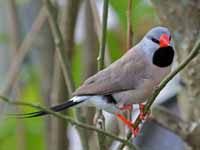
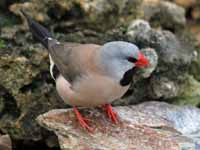
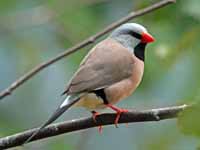

Finch,_Masked Poephila personata
Description: The masked finch has cinnamon-brown upperparts. The head is brown with a black mask. Some subspecies have a paler face. The underparts are paler with a black patch on the rear flanks. The masked finch is about 13 cm long. Their doomed nest may be located high in trees, but it can also be found in tall grass.
Range: Northern Australia.
Habitat: Grasslands, open woodlands.
Diet: Grass seeds; also insects during breeding season.
Conservation status: Least Concern.
Image by: 1, 3) Geoff Whalan 2) Brian_McCauley 4) SummerdroughtRange: Northern Australia.
Habitat: Grasslands, open woodlands.
Diet: Grass seeds; also insects during breeding season.
Conservation status: Least Concern.
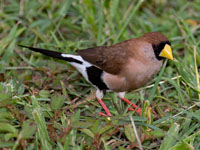
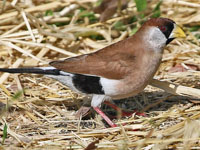
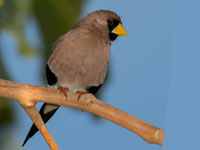
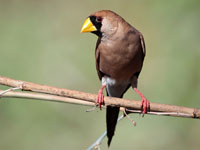
Genus Stagonopleura
These three firetail species are found in Australia. They have brown upperparts, a red rump, and also a red bill.
Firetail,_Beautiful Stagonopleura bella
Description: The beautiful firetail has mainly olive-brown upperparts. It has a black mask that which includes a narrow band across the base of the bill. There are spectacle like eye-rings. The bill is red, It has white underparts with fine pattern of black lines. The rump is black and the upper-tail coverts are bright red. It has pink legs. The male has some black on the lower belly. The beautiful firetail is 11 cm long.
Range: Southeastern Australia.
Habitat: Forests and shrublands that are near water.
Diet: Grass seeds; also insects and snails.
Conservation status: Least Concern.
Image by: 1, 3) JJ_Harrison - Tasmania 2) David Cook
Range: Southeastern Australia.
Habitat: Forests and shrublands that are near water.
Diet: Grass seeds; also insects and snails.
Conservation status: Least Concern.
1) Female 2, 3) Male


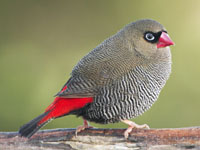
Firetail,_Diamond Stagonopleura guttata
Description: The diamond firetail has grey upperparts. The head is mostly grey with black lores, white forehead, and white cheeks. It has a black breast band that wraps around to cover the flanks. The flanks also have many white spots. The rest of the underparts are white. The rump and upper-tail coverts are bright red. It has a red bill and dark grey legs. The diamond firetai is up to 12 cm long.
Range: Eastern and southern Australia.
Habitat: Grasslands, woodlands, farms.
Diet: Seeds, fruit, and some insects.
Conservation status: Least Concern.
Image by: 1) JJ Harrison - Victoria, Australia 2) JJ_Harrison - New South Wales 2, 3) David Cook - Wamboin, NSW, Australia 4) birdsaspoetryRange: Eastern and southern Australia.
Habitat: Grasslands, woodlands, farms.
Diet: Seeds, fruit, and some insects.
Conservation status: Least Concern.
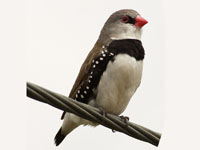
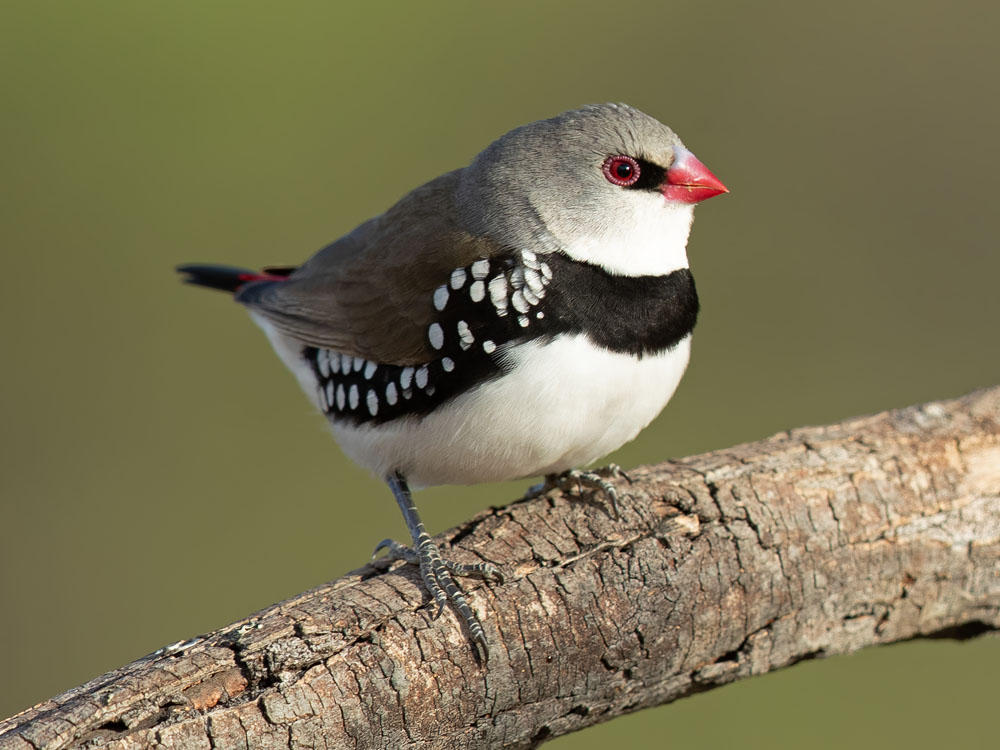

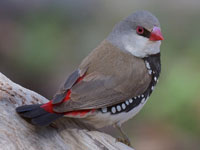
Firetail,_Red-eared Stagonopleura oculata
Description: The red-eared firetail has olive-brown upperparts. It has a black mask, pale blue eye-rings, and a red patch behind the eye. It has a red bill. The underparts are dark and covered with bold white spots. It has a bright red rump. The red-eared firetail is about 12 cm long.
Range: Southwest Australia.
Habitat: Dense vegetations of a forests understory. Prefers Eucalyptus forests. Also sedge habitats.
Diet: Seeds; also insects.
Conservation status: Least Concern.
Image by:
1) Laurie_Boyle 2) Jack_Snipe 3) Jean_HortRange: Southwest Australia.
Habitat: Dense vegetations of a forests understory. Prefers Eucalyptus forests. Also sedge habitats.
Diet: Seeds; also insects.
Conservation status: Least Concern.
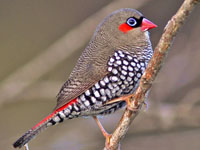
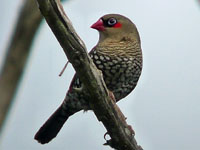
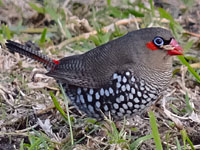
Genus Taeniopygia - 1 species
Finch,_Double-barred Stizoptera bichenovii)
Description: The double-barred finch, also known as the owl finch, has brownish-grey upperparts. It has black wings with white dots, a black tail, and a black rump (T, b, annulosa) or white rump (T. b. b.). Its white face is bordered with black, The white underparts have a black breast bar. It has blue-grey legs. These gregarious seed-eating birds build their nests in grass, a bush or low tree, and lay four eggs. The double-barred finch is up to 11 cn long.
Range: Northern and eastern Australia.
Habitat: Woodlands and scrublands with plentiful grasses, forest edges.
Diet: Grass and other seeds; also insects during breeding season.
Conservation status: Least Concern.
Image by: 1) Dick Daniels - Butterfly World in Florida 2) Brian_McCauley 3) Paul_Balfe 4) David Cook - ACT, Australia Range: Northern and eastern Australia.
Habitat: Woodlands and scrublands with plentiful grasses, forest edges.
Diet: Grass and other seeds; also insects during breeding season.
Conservation status: Least Concern.
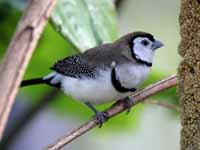
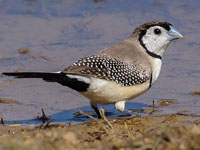


Genus Taeniopygia
These finches are found in Australia
Finch,_Zebra Taeniopygia guttata Found: Australia
Description: The male zebra finch has brownish-grey upperparts. It has orange cheeks and a vertical black line under the eye. The underparts are mainly off-white. There is a black breast bar and chestnut flanks with white spots. The tail has black-and-white barring. It has an orange to red bill, The female does not have orange cheeks or chestnut flanks. The zebra finch is about 10 cm long.
Range: Australia and the Lesser Sundas (islands to the north of Australia).
Habitat: Grasslands, rice fields, grassy woodlands.
Diet: Grass seeds.
Conservation status: Least Concern.
Image by: 1) Julie Burgher 2, 3) Peripitus 4) David Cook - Western AustraliaRange: Australia and the Lesser Sundas (islands to the north of Australia).
Habitat: Grasslands, rice fields, grassy woodlands.
Diet: Grass seeds.
Conservation status: Least Concern.
1) Pair 2) Female 3, 4) Male
